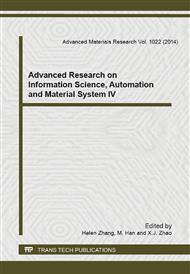[1]
A. Shanian and O. Savadogo. TOPSIS multiple-criteria decision support analysis for material selection of metallic bipolar plates for polymer electrolyte fuel cell. J. Power Sources Vol. 159 (2006) pp.1095-1104.
DOI: 10.1016/j.jpowsour.2005.12.092
Google Scholar
[2]
H. C. Liu, L. X. Mao, Z. Y. Zhang and P. Li. Induced aggregation operators in the VIKOR method and its application in material selection. Applied Mathematical Modelling, Vol. 37 (2013), pp.6325-6338.
DOI: 10.1016/j.apm.2013.01.026
Google Scholar
[3]
A. Kasaei, A. Abedian and A.S. Milani . An application of Quality Function Deployment method in engineering materials selection. Materials & Design, Vol. 55 (2014), pp.912-920.
DOI: 10.1016/j.matdes.2013.10.061
Google Scholar
[4]
A. Shanian and O. Savadogo. A material selection model based on the concept of multiple attribute decision making. Materials and Design Vol. 27 (2006), pp.329-337.
DOI: 10.1016/j.matdes.2004.10.027
Google Scholar
[5]
A. H. Peng and X. M. Xiao. Material selection using PROMETHEE combined with analytic network process under hybrid environment. Materials and Design, Vol. 47 (2013), pp.643-652.
DOI: 10.1016/j.matdes.2012.12.058
Google Scholar
[6]
P. Chatterjee, V. M. Athawale and S. Chakraborty. Materials selection using complex proportional assessment and evaluation of mixed data methods. Materials and Design vol. 32 (2011), pp.851-860.
DOI: 10.1016/j.matdes.2010.07.010
Google Scholar
[7]
R. J. Girubha and S. Vinodh. Application of fuzzy VIKOR and environmental impact analysis for material selection of an automotive component. Materials & Design, Vol. 37 (2012), P. 478-486.
DOI: 10.1016/j.matdes.2012.01.022
Google Scholar
[8]
H. C. Liu, L. Liu and J. Wu. Material selection using an interval 2-tuple linguistic VIKOR method considering subjective and objective weights. Materials and Design, Vol. 52 (2013) pp.158-167.
DOI: 10.1016/j.matdes.2013.05.054
Google Scholar
[9]
A. Jahan and K. L. Edwards. VIKOR method for material selection problems with interval numbers and target-based criteria. Materials and Design, Vol. 47 (2013), pp.759-765.
DOI: 10.1016/j.matdes.2012.12.072
Google Scholar
[10]
Y. M. Wang. A new method for multi-indices decision and evaluation-a project method. Journal of Systems Engineering and Electronics, Vol. 21 (1999), pp.1-4.
Google Scholar
[11]
Z.S. Xu. Uncertain Multiple Attribute Decision Making Methods and Applications. (Tsinghua University Press, Beijing 2004).
Google Scholar
[12]
Q. Z. Hu and W. H. Zhang. Study and Application of Interval Number Theory. (Science Press, Beijing 2010).
Google Scholar
[13]
B. H. Men and C. Liang. Attribute recognition model-based variation coefficient weight for evaluating water quality, Journal of Harbin Institute of Technology, Vol. 37 (2005), pp.1373-1375.
Google Scholar
[14]
A. S. Milani, A. Shanian, R. Madoliat and J. A. Nemes. The effect of normalization norms in multiple attribute decision making models: a case study in gear material selection. Structural and Multidisciplinary Optimization, Vol. 29 (2005).
DOI: 10.1007/s00158-004-0473-1
Google Scholar
[15]
P. Chatterjee and S. Chakraborty. Material selection using preferential ranking methods. Materials and Design, Vol. 35 (2012), pp.384-393.
DOI: 10.1016/j.matdes.2011.09.027
Google Scholar


